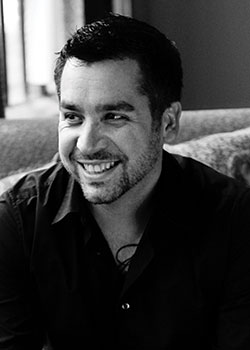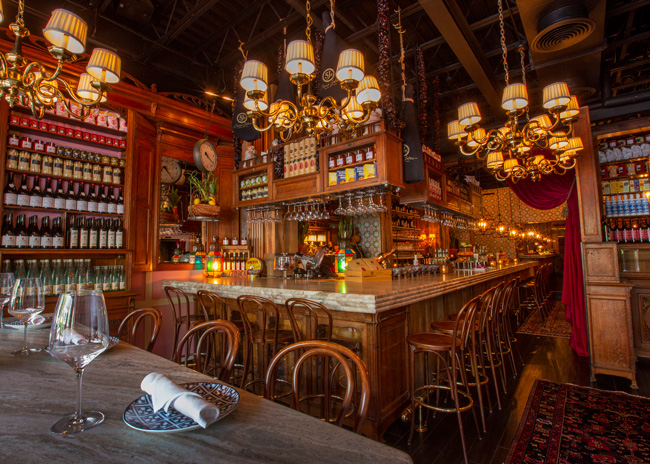 Joseph SzalaWe’re all familiar with restaurant interiors. We’re all also familiar with restaurant brands. But over the years, I’ve noticed something: More often than not, the brand identity does not align with the experience created by the interior design. Individually, both may be brilliant — each with their own moments of glory — but together, they fall short, and the gap created by various designers is visually obvious. I’m calling for a collective effort to end this disservice for the sake of our clients — and for our crafts.
Joseph SzalaWe’re all familiar with restaurant interiors. We’re all also familiar with restaurant brands. But over the years, I’ve noticed something: More often than not, the brand identity does not align with the experience created by the interior design. Individually, both may be brilliant — each with their own moments of glory — but together, they fall short, and the gap created by various designers is visually obvious. I’m calling for a collective effort to end this disservice for the sake of our clients — and for our crafts.
When someone visits a restaurant for the first time, it’s a moment of truth. Will perceptions be solidified? From the service to the food to the ambience, there are numerous opportunities to dent — even ruin — the brand as a whole. Despite the particular event’s weight, one mustn’t forget that the impression a guest leaves with doesn’t happen haphazardly.
Trying out a new restaurant (and subsequent visits) often happens only after countless touches with the brand. The prospective guest must hear about the restaurant first. Friends might have praised their experience. The prospective guest might read a review in a magazine or online. Maybe he or she saw an advertisement. Before entering the restaurant, many people visit the website to learn more about it. They may have even followed the restaurant on social media before visiting. Only
after these impressions does a consumer move from unaware and uninterested to an engaged customer.
Advertising, word of mouth, digital outlets, reviews and more all culminate to build expectations, guide perceptions and usher a person through the front doors for the first time. Once at the threshold of the restaurant itself, the space via architecture and interior continues the storytelling. Do the architecture and interior design continue the experience seamlessly or do they convey a different story about the brand?
Often, the brand experience before a first visit is vastly different than the on-site experience. The reason for this is quite clear: There was a blatant lack of collaboration and communication between the interior designers and the branding team. Generally, no single entity is at fault for the divide. In some cases, the architecture is well underway before a branding professional is brought on board, or vice versa. No matter the scenario, it’s rare that these two crucial partners communicate and collaborate the way they should.
Most restaurant startup projects see a mix of creatives working in tandem. Each partner focuses on his or her own discipline and on the process of ushering the client through discovery, design and implementation. In this typical scenario, a restaurant opens with a beautiful space and a beautiful brand. However, these two crucial parts of the overall brand experience compete more than they complement. They are often visually disjointed. It’s not always a glaring difference, and sometimes it’s not even consciously noticeable. However, there exists a visual and emotional rift where a holistic and symbiotic relationship should exist.
There are five key steps to ensure the branding team and the interiors team work to create a seamless experience for guests.
Start collaborating early. Collaboration between partners and client should start as early in the process as possible. Often, one partner starts before the other. In those cases, an onboarding session, or even multiple sessions, is crucial to team building. The client should be included to ensure their vision isn’t misinterpreted or skewed. Collaboration leads to bigger and better ideas for all parties and to a stronger project overall. Stifling the collaborative process leads to linear, myopic thinking and ideas. There is power in numbers, which leads to stronger, more innovative results for all. The sooner collaboration is introduced, the better.
Optimize similar processes. We all have our own process that we usher clients through to get optimal results. Serendipitously, our processes often share many commonalities, but it’s the outputs that have differences. Every creative firm, be it brand or architecture, goes through a discovery process where we learn more about our clients’ needs, wants and vision. Some of those needs and wants may be specific to the output, but a lot of the discussions are more conceptual and higher level. Those discovery sessions should be shared to optimize the process and ensure every team member shares the brand vision. Moving deeper into the process, there are other opportunities that partners should seek to align so the experience is best for the client and brand.
Set a collaboration schedule. Collaboration is often treated as a box to be checked — one that offers little real value. After that is completed, each party returns to their business to perform their tasks as usual without much follow-up interaction. This is where small gaps turn into great divides, leaving one party to play catch-up to the other or, in worst-case scenarios, go off in a direction that makes the brand’s experiences disjointed.
Check the egos. It’s a natural inclination to protect one’s team and to feel that your piece of the project and your own discipline has great importance to the project overall. Egos never produce the best results, and when collaboration is a means to a more creative and valuable end, the ego has no business being present. As professionals who are experienced and creative, it’s easy to fall in love with your own ideas. We must all actively check our egos and keep our focus on what’s most important: the client’s brand and vision.
Prepare and support your team. It’s hard enough to put aside strong opinions and personalities within your own creative team. Add in more team members, and the task becomes exponentially more complex. It should be the job and focus of the principals to prepare teams for collaboration with outside partners. Discuss the scenario and the desired outcome with your team. Field pertinent questions to ease apprehensions or discuss best practices. Guide the team’s collective expectations, then leave an open door for airing grievances during the project.
We live in a world where creativity is in no short supply. Whether you’re a seasoned architect, a fresh brand designer or an artisan with an eye for beauty, you work in an area where new ideas are churned out at an astounding rate every minute of every day. Creativity is a valuable resource for those opening new restaurants as they can access it in every city across the world. Despite the enormous amount of creativity and high-quality design available today, however, we still have a problem. There’s a gap between how our different disciplines collaborate — and that gap causes a rift between experiences within a restaurant’s brand landscape.



